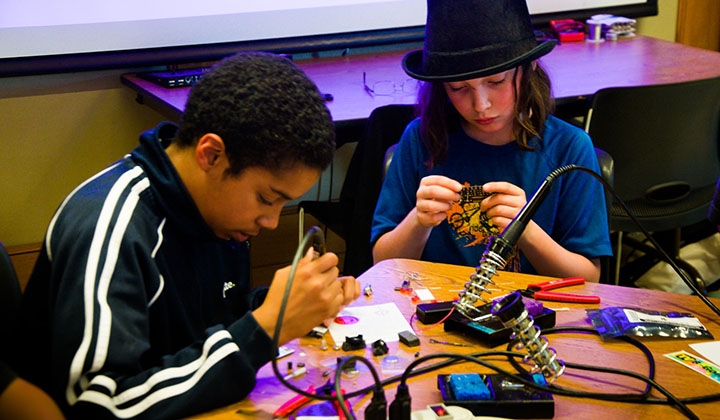Assignment X: Inspiring a Sense of Curiosity in Library Patrons

Teens learning how to solder at a workshop held at the San Francisco Public Library Bernal Heights location in November 2013 (O’Brian, 2019).
After having read, watched, and explored through the first few modules of the course, I was reminded of one of the key reasons why I first thought to apply to SJSU to study Library and Information Science. That reason was curiosity, and not just my own curiosity regarding the details of the program itself, but also curiosity regarding how libraries, museums, and archives can each spark a sense of curiosity in their patrons and allow it to influence each patron’s own unique experience making use of the services provided to them by each of these institutions.
Curiosity may have been the thing which killed the metaphorical cat (don’t worry, by the way, my real cats are all doing just fine), but it can also be a driving force behind why someone might want to visit their local library and may lead to them becoming a repeat visitor of said library. I know that was certainly the case for my brothers and I when we were young. We were always very curious children seeking new information about the world outside and the many things which make it up and our local library system held a number of programs over the years which helped to feed our growing curiosity; this in turn helped inspire a love and appreciation for our public library which persists to this day.
With the rise of the internet, it has never been easier for someone to feed their curious mind. As Michael Stephens notes in his book, The Heart of Librarianship, “The most powerful information services to date are probably found in the palm of everyone’s hand” (2). All one likely needs to do is pull out their smart device and type the subject of their curiosity into a search bar, or use a voice assistant such as Siri or Alexa if available, and they can quickly find information on the subject in question. But even putting aside for a moment the issue of the validity and trustworthiness of all the new information found this way (which is an important issue itself to talk about, albeit not one strictly related to this post), not all curiosities can be contented by simply coming across new pieces of information from library materials or the internet. A lot of them can only be truly satisfied by doing or making something; after all, there’s only so much you can learn about topics like sewing and robotics without putting the required knowledge into practice. This is why modern library models such as the four-space model promote the public library as a place of performance and creativity in addition to a place of learning, inspiration, and participation (Skot-Hansen, 2017). Libraries can be so much more to their patrons and communities than just a collection of media, and can inspire their curiosity and creativity in numerous ways.
Several libraries have already come to this realization. The San Francisco Public Library, for example, has a large space for teenage patrons called The Mix which allows them to just hang out and freely participate in a variety of activities that might pique their interest, like jamming out in a music studio or learning how to solder (O’Brian, 2019). They also offer passes to local museums, gardens, galleries, swimming pools, and state parks to their cardholders, along with having a seed lending library at one of their branch locations (Ferrell, 2022). Libraries such as North Carolina State University’s James B. Hunt, Jr. Library (NC State, 2013) and Chicago Public Library (2018) also seem to facilitate curiosity and creativity among their patrons, and hopefully many more libraries will explore similar offerings in the coming years and create opportunities for people of all ages to find and explore things they are interested in. After all, a curious mind is a healthy mind, and kids, teens, and adults alike all deserve opportunities to satisfy their curiosity.
References:
Chicago Public Library. (2018, April 11). YOUmedia at CPL [Video]. YouTube. https://www.youtube.com/watch?v=v8G4nnlgKmk
Ferrell, J. (2022, September 15). 13 awesome free things you can do with an SF Public Library card. Secret San Francisco. https://secretsanfrancisco.com/sf-public-library-card/
NC State. (2013, April 3). NC State University’s James B. Hunt, Jr. Library [Video]. YouTube. https://www.youtube.com/watch?v=scyQPk6n0xA
O’Brian, C. (2019, June 24). How San Francisco’s public libraries are embracing their changing role. Shareable. https://www.shareable.net/how-san-francisco-public-libraries-are-embracing-their-changing-role/
Skot-Hansen, D. (2017, August). Library development: From collection to connection. University of Copenhagen. https://287.hyperlib.sjsu.edu/wp-content/uploads/2025/02/4-Spaces-Model-from-Univ-Copoenhagen.pdf
Stephens, M. (2016). The heart of librarianship: Attentive, positive, and purposeful change. ALA Editions.
0 Comments